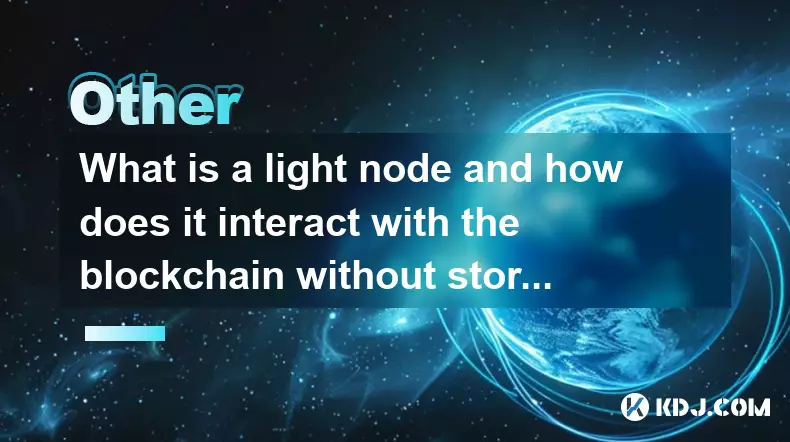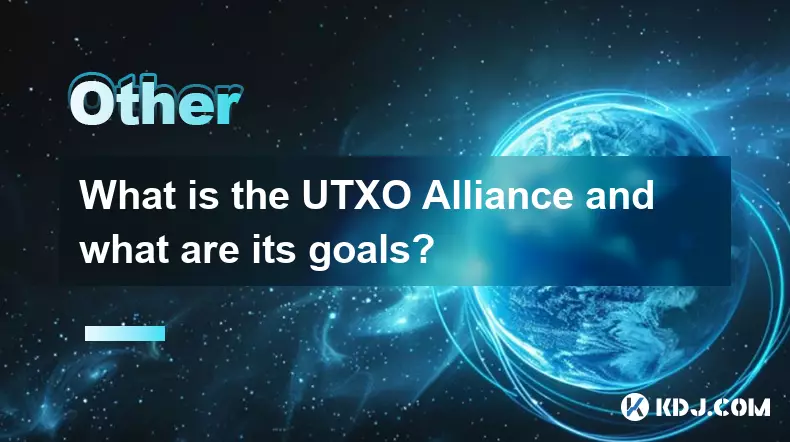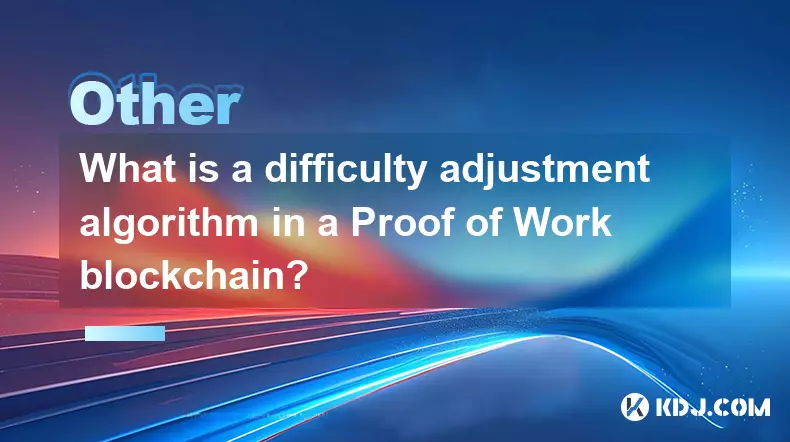-
 bitcoin
bitcoin $101752.865364 USD
-1.09% -
 ethereum
ethereum $3382.985899 USD
-1.38% -
 tether
tether $0.999658 USD
0.04% -
 xrp
xrp $2.272505 USD
-1.51% -
 bnb
bnb $989.089004 USD
0.14% -
 solana
solana $156.962612 USD
-3.08% -
 usd-coin
usd-coin $0.999776 USD
0.01% -
 tron
tron $0.290786 USD
-0.69% -
 dogecoin
dogecoin $0.174594 USD
-2.86% -
 cardano
cardano $0.560085 USD
-3.55% -
 hyperliquid
hyperliquid $40.023704 USD
-5.75% -
 chainlink
chainlink $15.324649 USD
-2.78% -
 bitcoin-cash
bitcoin-cash $493.576540 USD
-3.52% -
 zcash
zcash $571.320038 USD
-12.05% -
 stellar
stellar $0.280066 USD
-4.26%
What is a light node and how does it interact with the blockchain without storing all data?
Light nodes enable blockchain access on low-power devices by verifying transactions via Merkle proofs without storing the full ledger.
Nov 09, 2025 at 08:00 am

Understanding Light Nodes in Blockchain Networks
1. A light node, also known as a lightweight client, is a type of blockchain node that does not download or store the complete blockchain ledger. Instead, it operates by connecting to full nodes and requesting only specific data relevant to its transactions. This design allows devices with limited storage capacity, such as smartphones or tablets, to participate in the network without requiring extensive hardware resources.
2. Unlike full nodes that validate every block and transaction, light nodes rely on a method called Simplified Payment Verification (SPV). SPV enables these nodes to verify the authenticity of transactions by checking headers from the longest proof-of-work chain and confirming that a transaction exists within a block’s Merkle tree. This process drastically reduces the amount of data that must be processed and stored.
3. Light nodes communicate with full nodes over peer-to-peer protocols to request information such as block headers or specific transaction details. They do not contribute to network consensus or independently validate entire blocks. Their primary function is to monitor wallet balances and confirm incoming payments efficiently.
4. By downloading only block headers—typically 80 bytes each—light nodes maintain awareness of the blockchain’s state while minimizing bandwidth usage. Each header contains metadata like timestamp, nonce, and the Merkle root, which serves as a cryptographic summary of all transactions in the block.
5. Security considerations arise because light nodes trust full nodes to provide accurate data. While they can detect inconsistencies through cryptographic proofs, they cannot independently catch fraudulent blocks. Users must connect to honest full nodes to avoid potential deception.
Data Efficiency Through Merkle Proofs
1. The efficiency of light nodes hinges on Merkle trees, a binary hash structure used to summarize all transactions in a block. Each leaf node represents a transaction hash, and parent nodes are formed by hashing pairs of child nodes until a single root hash—the Merkle root—is produced.
2. When a light node needs to verify a transaction, it requests the Merkle path (also called a Merkle proof) from a full node. This path includes the hashes necessary to reconstruct the route from the transaction to the Merkle root included in the block header.
3. Using this path, the light node performs local hashing operations to compute the expected Merkle root. If it matches the one in the verified block header, the transaction is confirmed as part of that block.
4. This mechanism ensures data integrity without requiring access to every transaction. It allows light nodes to operate securely while interacting with minimal data, making them ideal for mobile wallets and decentralized applications on constrained devices.
5. Because Merkle proofs are compact and deterministic, they enable fast verification across low-bandwidth connections. This feature is essential for scaling blockchain accessibility beyond high-powered infrastructure.
Role of Light Nodes in Decentralized Applications
1. In the ecosystem of decentralized finance (DeFi), light nodes empower users to interact with smart contracts and dApps directly from personal devices. Wallets like MetaMask use light client principles to query Ethereum nodes via services like Infura or Alchemy.
2. These wallets retrieve balance information, gas prices, and transaction statuses without hosting a full Ethereum node. They rely on remote procedure calls (RPCs) to external providers that serve as intermediaries between the user and the blockchain.
3. Some emerging protocols aim to enhance the autonomy of light clients by integrating fraud proofs or validity proofs, especially in layer-2 solutions. For example, optimistic rollups allow light nodes to challenge incorrect state assertions using verifiable delay mechanisms.
4. Projects like Ethereum’s stateless client initiative and Bitcoin’s Neutrino protocol refine light node capabilities by introducing UTXO commitments and efficient filtering techniques. Such advancements reduce dependency on centralized gateways.
5. Despite their limitations in validation power, light nodes expand inclusivity by enabling broader participation in blockchain networks. Their presence supports decentralization by reducing barriers to entry for everyday users.
Light nodes make blockchain accessible by minimizing storage and bandwidth demands while maintaining secure transaction verification through cryptographic proofs.
Frequently Asked Questions
Can a light node send transactions to the blockchain?Yes, a light node can create and broadcast transactions. It constructs the transaction locally and sends it to connected full nodes, which propagate it across the network for inclusion in a block.
Do light nodes contribute to blockchain security?Indirectly. While they don’t validate every block, their presence increases network resilience by expanding the user base. Some advanced implementations allow light nodes to participate in monitoring and reporting anomalies.
How do light nodes choose which full nodes to connect to?They typically discover peers through DNS seeds or hardcoded addresses, then establish connections based on responsiveness and reliability. Users may manually configure trusted nodes for improved privacy and control.
Are there any privacy risks when using a light node?Yes. Since light nodes query full nodes for specific data, those servers can potentially link queries to IP addresses, revealing user activity patterns. Techniques like Bloom filters or connection through Tor help mitigate exposure.
Disclaimer:info@kdj.com
The information provided is not trading advice. kdj.com does not assume any responsibility for any investments made based on the information provided in this article. Cryptocurrencies are highly volatile and it is highly recommended that you invest with caution after thorough research!
If you believe that the content used on this website infringes your copyright, please contact us immediately (info@kdj.com) and we will delete it promptly.
- Ripple (XRP) in 2026: Hold or Fold? A Look at XRP's Future and Emerging DeFi Alternatives
- 2025-11-08 18:35:01
- Zcash ZEC Coin Price Explosion: From Privacy Niche to Center Stage
- 2025-11-08 18:55:01
- Berachain Price Prediction: Navigating the Honeycomb Hype in Crypto
- 2025-11-08 18:55:01
- Arthur Hayes, Gold, and Bitcoin: A Modern Monetary Trinity?
- 2025-11-08 19:15:01
- Shiba Inu's Next Move: Navigating a Shifting Market
- 2025-11-08 19:20:01
- Pakistan's Crypto Crossroads: Balancing Opportunity with Asset-Backed Realities
- 2025-11-08 19:20:01
Related knowledge

What are intents in crypto and how do they change user interaction?
Nov 09,2025 at 09:00am
Understanding the Role of Decentralized Exchanges in Modern Crypto Trading1. Decentralized exchanges, commonly known as DEXs, have reshaped how trader...

What is a cryptographic nonce and how is it used to prevent replay attacks?
Nov 08,2025 at 05:00pm
Understanding Cryptographic Nonces in Blockchain Systems1. A cryptographic nonce is a number used only once within a specific cryptographic communicat...

What are the trade-offs between liveness and safety in a consensus protocol?
Nov 09,2025 at 12:20pm
Understanding the Role of Liquidity Pools in Decentralized Finance1. Liquidity pools are foundational components within decentralized exchanges (DEXs)...

What is a call data in an Ethereum transaction and how is it used?
Nov 09,2025 at 01:59am
Understanding Call Data in Ethereum Transactions1. Call data refers to the information sent along with a transaction on the Ethereum network that spec...

What is the UTXO Alliance and what are its goals?
Nov 09,2025 at 01:39pm
Understanding the UTXO Alliance1. The UTXO Alliance is a collaborative initiative formed by prominent blockchain projects and developers who support t...

What is a difficulty adjustment algorithm in a Proof of Work blockchain?
Nov 09,2025 at 08:20am
Understanding the Role of Difficulty Adjustment in Proof of Work1. A difficulty adjustment algorithm is a core mechanism in Proof of Work (PoW) blockc...

What are intents in crypto and how do they change user interaction?
Nov 09,2025 at 09:00am
Understanding the Role of Decentralized Exchanges in Modern Crypto Trading1. Decentralized exchanges, commonly known as DEXs, have reshaped how trader...

What is a cryptographic nonce and how is it used to prevent replay attacks?
Nov 08,2025 at 05:00pm
Understanding Cryptographic Nonces in Blockchain Systems1. A cryptographic nonce is a number used only once within a specific cryptographic communicat...

What are the trade-offs between liveness and safety in a consensus protocol?
Nov 09,2025 at 12:20pm
Understanding the Role of Liquidity Pools in Decentralized Finance1. Liquidity pools are foundational components within decentralized exchanges (DEXs)...

What is a call data in an Ethereum transaction and how is it used?
Nov 09,2025 at 01:59am
Understanding Call Data in Ethereum Transactions1. Call data refers to the information sent along with a transaction on the Ethereum network that spec...

What is the UTXO Alliance and what are its goals?
Nov 09,2025 at 01:39pm
Understanding the UTXO Alliance1. The UTXO Alliance is a collaborative initiative formed by prominent blockchain projects and developers who support t...

What is a difficulty adjustment algorithm in a Proof of Work blockchain?
Nov 09,2025 at 08:20am
Understanding the Role of Difficulty Adjustment in Proof of Work1. A difficulty adjustment algorithm is a core mechanism in Proof of Work (PoW) blockc...
See all articles





















![The Graph Price Prediction [GRT Crypto Price News Today] The Graph Price Prediction [GRT Crypto Price News Today]](/uploads/2025/11/07/cryptocurrencies-news/videos/690d4df44fe69_image_500_375.webp)




















































